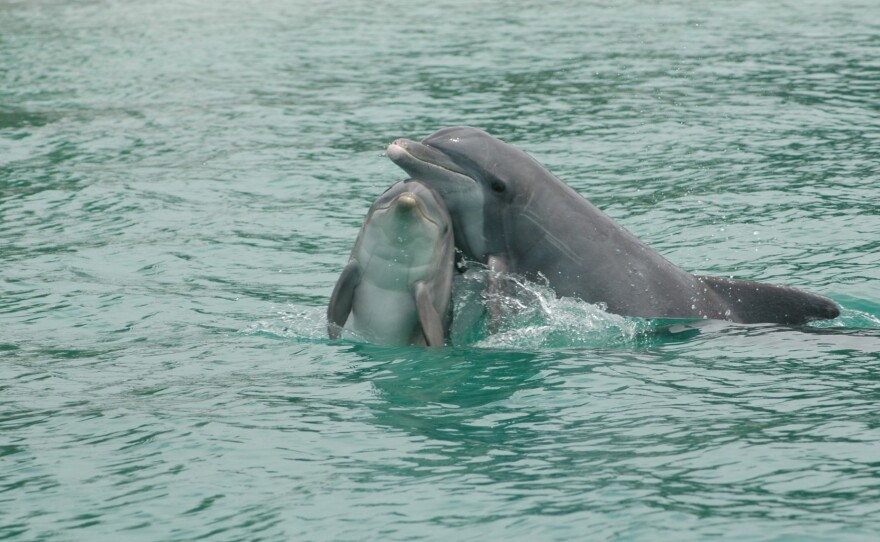Laela Sayigh is getting ready to go see some old friends. Sayigh is a senior research specialist in the biology department at Woods Hole Oceanographic Institution. She’s headed down to Sarasota, Fla., where she’s been studying dolphin communication with the same population of bottlenose dolphins for nearly 40 years.
“It's really like a natural laboratory, she said. “There's a resident population, about 170 animals, and all of them are known to the researchers, their ages, sexes, who their moms and grandmothers, etc., up to six generations, and who they hang out with. So, it’s really an amazing opportunity to study communication, because there's so much known about their relationships.”
Researchers at the Brookfield Zoo Chicago's Sarasota Dolphin Research Program
have been studying this population year-round for decades, and that historical data is critical to Sayigh’s work. Her research suggests the way dolphins and humans communicate may have more in common than you might think.
Sayigh has spent much of her career identifying and cataloging each dolphin’s unique signature whistle. The whistles function somewhat like a human name in that they help dolphins identify each other.
Dolphins vocalize their own signature whistles and sometimes imitate others’. Researchers say that may be like humans calling a friend by name or even talking about them when they’re not around.
Sayigh and her team have also concluded that, like human mothers, dolphins change their tone when whistling to their young.
“We don’t know if it functions in any way similarly, but humans tend to speak in a higher-pitched, more sing-songy type voice with infants and children, and we found that bottlenose dolphins, females, when they’re communicating with their calves, will increase the pitch of their signature whistles,” Sayigh said.
In May, Sayigh was awarded the first annual Coller Dolittle prize, sponsored by the Jeremy Coller Foundation. The $100,000 purse is meant to fund research that supports progress toward interspecies communication. And Sayigh is using part of the prize money to fund her fieldwork in Sarasota this fall.
But the prize was not awarded for her WHOI team’s extensive catalog of signature whistles. It was given for the identification of outliers – non-signature whistles, used by dozens of dolphins throughout the population.
Sayigh and her team use non-invasive acoustic tags and underwater microphones, called hydrophones, which they suction cup to the dolphins. From those recordings they create spectrograms, so they can analyze the whistles visually.
“When I first noticed it, I honestly kind of thought I was like going bonkers because we'd always just sort of ignored these whistles,” she said. “And I was like, this is definitely happening. And some of them are quite unusual, too.”
The work on non-signature whistles is in its early stages and has yet to be peer-reviewed. But the team reports finding more than 20 non-signature whistles. Sayigh says, so far, she is concentrating on just a couple.
“I'm just focusing right now on two different non-signature whistle types to see if I can get a large enough sample size of those across a lot of different age, sex, context, generations,” she said. “But then of course, we would want to expand that to other non-signature whistle types too.”
The first whistle Sayigh is studying, she says is quite distinctive.
“That was so unusual that I literally at first wasn't even sure that it was a dolphin,” she said. “But now I've seen probably 30 different animals making that whistle.”
That whistle has short, punctuated sweeps in tone.
“Our preliminary analyses that I've done of that whistle are suggestive that it could be some type of alarm signal,” Sayigh explained. “So, some kind of alerting animals to danger or concern of some kind.”
The other non-signature whistle she’ll be experimenting with in Sarasota, Sayigh theorizes, is a kind of like a dolphin saying, “Huh?”
“We think now what they were doing was sort of expressing surprise,” she said. “That's our best guess about how this whistle functions now anyway, is that is that it's sort of a ‘what was that?’ kind of thing.”
As Sayigh heads to Sarasota to run more experiments on non-signature whistles, she’s also directed some of her prize money to colleagues in Denmark who are helping to build a catalog of those whistle types. The goal is to utilize artificial intelligence to help classify non-signature whistles.
Sayigh says Jeremy Coller, the British financier behind the Coller-Dolittle prize, is interested in harnessing AI. And, in addition to the annual $100,000 prize, there’s a major award of either $500,000 cash or a ten-million-dollar equity investment for the team that “cracks the code of interspecies communication.”










